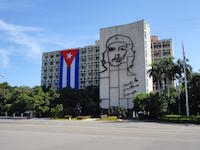by Deborah Dimmett, University of Arizona
 As teachers, one of the tasks delegated to us is selecting texts for students to read. But, in choosing a text, we need to ask ourselves what it is we want the text to do for us. And, how will students be supported when they identify conflicting discourses—particularly those that conflict with the teacher’s original intentions?
As teachers, one of the tasks delegated to us is selecting texts for students to read. But, in choosing a text, we need to ask ourselves what it is we want the text to do for us. And, how will students be supported when they identify conflicting discourses—particularly those that conflict with the teacher’s original intentions?
I recall the first time I traveled to Cuba in 1993. I just returned from my first trip a few days before the start of school, but I was prepared for the first lesson. I shared with my middle school students a slideshow of the photos I took with the intention of imparting to them a picaresque and culturally rich Cuba that few Americans had ever experienced. Photos included the cityscape of Havana, the Malecón, antique cars commonly in use, rumba fiestas, billboards of Fidel Castro and Ché Guevara touting “Viva la revolución!” and, of course, the countryside. Musical accompaniments including son, rumba, and other Afro-Cuban songs and rhythms were carefully interwoven with the presentation along with short interludes of discussions about everyday life in Cuba. To my chagrin, the initial responses from students were quite different than I expected. What I heard is, “Ooh, it’s dirty!,” “Why don’t they get out?,” “Why is everything so old?,” “Why don’t we (Americans) go help them?” Although I tried to not use their questions to launch a productive discussion, I couldn’t help but feel deflated. What did I have to have the text (the slideshow) do for me? This had not been fully addressed, as the presentation was mostly a “show and tell.” I had not considered that students’ background knowledge and the discourses that form their thinking might be in contrast to my own.
Four years later, I visited Haiti for the first time and compiled photos and music to share with my middle school students at the start of the school year. However, rather than engaging them in a discussion where I had already determined the discourses that would be gleaned from the presentation, I followed the slideshow with a “silent discussion” where students responded on chart paper to the photos laid across it. We reviewed some of the comments, and I addressed most of their questions as objectively as possible. Then I had the students interview a photo of their choice and write a poem with “the responses.” This activity allowed for a wide variety of readings of the photos. Together as a class we discussed all of the different ways we might think of Haiti. And, we used the exercise to identify discourses and assumptions that informed our thinking.
Why did I choose photos as my texts? In particular, why did I choose photos of Cuba and Haiti? What did I hope for students to learn from the activities? And, were these activities productive? The presentation on Cuba carried with it pre-conceived discourses that I wanted my students to understand and buy into. It did not take into consideration that students might have other responses that could have resulted in a lesson using discourse analysis. The exercises following the presentation of Haiti demonstrates a willingness on my part to engage students in the identification of all of the discourses they might associate with the images of Haiti.
Although these lessons used photos rather than books, they raise a critical question about how we as teachers choose texts and what we do to limit students understanding of those texts when actually we should be opening up meanings of the text by giving students the opportunity to identify the numerous discourses that the text engages.
Journey through Worlds of Words during our open reading hours: Monday-Friday, 9 a.m. to 5 p.m. and Saturday, 9 a.m. to 1 p.m. To view our complete offerings of WOW Currents, please visit archival stream.
- Themes: Deborah Dimmett
- Descriptors: Debates & Trends, Student Connections, WOW Currents
